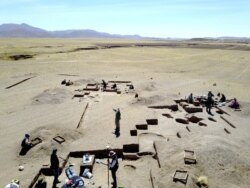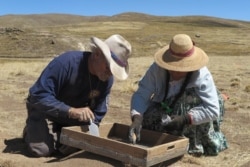In the Stone Age Americas, a woman's place was on the hunt, according to a new study.
A 9,000-year-old burial site in Peru has scientists rethinking ideas about gender roles in prehistoric hunter-gatherer societies.
The findings go against what researchers have seen in nearly all other hunter-gatherer cultures, and not all archaeologists are convinced.
In the new study, in the journal Science Advances, archaeologists found the remains of a teenage female buried with what appears to be a complete set of big-game hunting gear: spear points, blades, scrapers and other stone tools.
He's a she
They could not tell the individual's gender at the dig site, but "we all just assumed it was a dude," University of California Davis archaeologist Randy Haas said.
Around the site, they told each other he must have been a great hunter, Haas said.
"Maybe he was a big chief or a great warrior or something," he said.
But after studying the remains back at the lab, his colleague Jim Watson of the University of Arizona said, "I think 'he' is a 'she,'" Haas said.
"It definitely was a surprise for me," he added.
In nearly every hunter-gatherer culture studied, big-game hunting is done almost exclusively by men. Anthropologists for the most part have assumed that that is how it has always been.
So, was this an isolated case? Or were prehistoric women hunters more common than previously thought?
These are hard questions to answer because these sites are hard to find.
"You don't just stumble across a burial like this every day," Haas said.
"So we did the next best thing," he added. They looked at the published records from half a century of previous digs across North and South America.
Out of 429 sets of remains, 16 males and 11 females were buried alongside big-game hunting gear – a surprisingly even match.
Women's work
The women had not been identified as hunters before, however. Haas notes that at some other sites, the tools were described not as hunting gear but as tools for preparing food or clothing, which were considered women's work.
In one case, a researcher challenged DNA results that identified the person as female explicitly because the remains were found with hunting tools.
Sexism could be a factor, Haas said.
He pointed to "many waves of feminist scholars saying, ‘Hey, we need to rethink these things.’"
Plus, with 50 years of archaeological data in hand, Haas said, "now, we finally had the opportunity to zoom out" and see the big picture.
The case is not settled, however.
A lot can happen to a burial site in 9,000 years. Remains degrade, and gender gets harder to identify. Objects found near an individual may not have been there when the body was buried.
Of the 11 females found with hunting gear, scientists conclusively determined the gender and association with the tools for only three of them, including the one Haas’ team found.
"By expanding their scope to include only tentative associations, Haas (and colleagues) render the hypothesis more tentative as well," archaeologist Ben Potter of the Liaocheng University Arctic Studies Center wrote in an email.
"I’m not convinced their analysis overwhelms the extensive data on hunter-gatherer sexual division of labor," Potter added.
Changing roles
Others said the study is controversial but compelling.
"I think it does a pretty good job of showing that gender roles deep in antiquity ... were probably less prescribed than they were later in time," said archaeologist Bill Hildebrandt with the Far Western Anthropological Research Group.
Hildebrandt has studied an 8,000-year-old culture in Southern California that did not seem to have rigid gender roles.
Looking at more recent hunter-gatherer cultures, "we would think that there wasn't much change in how men and women interacted with one another," he said. "But when you're willing to look at the old archaeological record, sometimes you find things you don't expect."
"That's why we do archaeology," he said, "to discover things that we didn't know."
Besides, he added, "women's roles have been changing a lot in the last 20 or 30 years within our society. So it makes sense that women's roles could be variable deep in antiquity as well."






